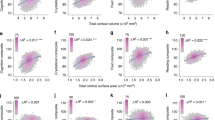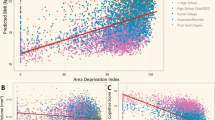Abstract
Socioeconomic disparities are associated with differences in cognitive development. The extent to which this translates to disparities in brain structure is unclear. We investigated relationships between socioeconomic factors and brain morphometry, independently of genetic ancestry, among a cohort of 1,099 typically developing individuals between 3 and 20 years of age. Income was logarithmically associated with brain surface area. Among children from lower income families, small differences in income were associated with relatively large differences in surface area, whereas, among children from higher income families, similar income increments were associated with smaller differences in surface area. These relationships were most prominent in regions supporting language, reading, executive functions and spatial skills; surface area mediated socioeconomic differences in certain neurocognitive abilities. These data imply that income relates most strongly to brain structure among the most disadvantaged children.
This is a preview of subscription content, access via your institution
Access options
Subscribe to this journal
Receive 12 print issues and online access
$209.00 per year
only $17.42 per issue
Buy this article
- Purchase on Springer Link
- Instant access to full article PDF
Prices may be subject to local taxes which are calculated during checkout



Similar content being viewed by others
References
Rosenzweig, M.R. Effects of differential experience on the brain and behavior. Dev. Neuropsychol. 24, 523–540 (2003).
Sowell, E.R. et al. Mapping cortical change across the human life span. Nat. Neurosci. 6, 309–315 (2003).
McLoyd, V.C. Socioeconomic disadvantage and child development. Am. Psychol. 53, 185–204 (1998).
Brooks-Gunn, J. & Duncan, G.J. The effects of poverty on children. Future Child. 7, 55–71 (1997).
Hackman, D.A. & Farah, M.J. Socioeconomic status and the developing brain. Trends Cogn. Sci. 13, 65–73 (2009).
Noble, K.G., Wolmetz, M.E., Ochs, L.G., Farah, M.J. & McCandliss, B.D. Brain-behavior relationships in reading acquisition are modulated by socioeconomic factors. Dev. Sci. 9, 642–654 (2006).
Raizada, R.D., Richards, T.L., Meltzoff, A. & Kuhl, P.K. Socioeconomic status predicts hemispheric specialisation of the left inferior frontal gyrus in young children. Neuroimage 40, 1392–1401 (2008).
Stevens, C., Lauinger, B. & Neville, H. Differences in the neural mechanisms of selective attention in children from different socioeconomic backgrounds: an event-related brain potential study. Dev. Sci. 12, 634–646 (2009).
Sheridan, M.A., Sarsour, K., Jutte, D., D'Esposito, M. & Boyce, W.T. The impact of social disparity on prefontal function in childhood. PLoS ONE 7, e35744 (2012).
Tomalski, P. et al. Socioeconomic status and functional brain development – associations in early infancy. Dev. Sci. 16, 676–687 (2013).
Kim, P. et al. Effects of childhood poverty and chronic stress on emotion regulatory brain function in adulthood. Proc. Natl. Acad. Sci. USA 110, 18442–18447 (2013).
Sowell, E.R. et al. Longitudinal mapping of cortical thickness and brain growth in normal children. J. Neurosci. 24, 8223–8231 (2004).
Noble, K.G. et al. Hippocampal volume varies with educational attainment across the life-span. Front. Hum. Neurosci. 6, 1–12 (2012).
Noble, K.G., Houston, S.M., Kan, E. & Sowell, E.R. Neural correlates of socioeconomic status in the developing human brain. Dev. Sci. 15, 516–527 (2012).
Noble, K.G., Korgaonkar, M.S., Grieve, S.M. & Brickman, A.M. Higher education is an age-independent predictor of white matter integrity and cognitive control in late adolescence. Dev. Sci. 16, 653–664 (2013).
Chiang, M.-C. et al. Genetics of white matter development: A DTI study of 705 twins and their siblings aged 12 to 29. NeuroImage 54, 2308–2317 (2010).
Hanson, J.L., Chandra, A., Wolfe, B.L. & Pollak, S.D. Association between income and the hippocampus. PLoS ONE 6, e18712 (2011).
Hanson, J.L. et al. Family poverty affects the rate of human infant brain growth. PLoS ONE 8, e80954 (2013).
Jednoróg, K. et al. The influence of socioeconomic status on children's brain structure. PLoS ONE 7, e42486 (2012).
Lawson, G.M., Duda, J.T., Avants, B.B., Wu, J. & Farah, M.J. Associations between children's socioeconomic status and prefrontal cortical thickness. Dev. Sci. 16, 641–652 (2013).
Luby, J. et al. The effects of poverty on childhood brain development: the mediating effect of caregiving and stressful life events. JAMA Pediatr. 167, 1135–1142 (2013).
Staff, R.T. et al. Childhood socioeconomic status and adult brain size: childhood socioeconomic status influences adult hippocampal size. Ann. Neurol. 71, 653–660 (2012).
Raznahan, A. et al. How does your cortex grow? J. Neurosci. 31, 7174–7177 (2011).
Sowell, E.R. et al. Sex differences in cortical thickness mapped in 176 healthy individuals between 7 and 87 years of age. Cereb. Cortex 17, 1550–1560 (2007).
Schnack, H.G. et al. Changes in thickness and surface area of the human cortex and their relationship with intelligence. Cereb. Cortex published online, doi:10.1093/cercor/bht357 (9 January 2014).
Shaw, P. et al. Intellectual ability and cortical development in children and adolescents. Nature 440, 676–679 (2006).
Grieve, S.M., Korgaonkar, M.S., Clark, C.R. & Williams, L.M. Regional heterogeneity in limbic maturational changes: Evidence from integrating cortical thickness, volumetric and diffusion tensor imaging measures. Neuroimage 55, 868–879 (2011).
Duncan, G.J. & Magnuson, K.A. Can family socioeconomic resources account for racial and ethnic test score gaps? Future Child. 15, 35–54 (2005).
Duncan, G.J. & Magnuson, K. Socioeconomic status and cognitive functioning: moving from correlation to causation. Wiley Interdiscip. Rev. Cogn. Sci. 3, 377–386 (2012).
Vannest, J., Karunanayaka, P.R., Schmithorst, V.J., Szaflarski, J.P. & Holland, S.K. Language networks in children: Evidence from functional MRI studies. AJR Am. J. Roentgenol. 192, 1190–1196 (2009).
McCandliss, B.D. & Noble, K.G. The development of reading impairment: a cognitive neuroscience model. Ment. Retard. Dev. Disabil. Res. Rev. 9, 196–204 (2003).
Gianaros, P.J. et al. Perigenual anterior cingulate morphology covaries with perceived social standing. Soc. Cogn. Affect. Neurosci. 2, 161–173 (2007).
Casey, B.J. et al. A developmental functional MRI study of prefrontal activation during performance on a go-no-go task. J. Cogn. Neurosci. 9, 835–847 (1997).
Klingberg, T., Forssberg, H. & Westerberg, H. Increased brain activity in frontal and parietal cortex underlies the development of visuospatial working memory capacity during childhood. J. Cogn. Neurosci. 14, 1–10 (2002).
Noble, K.G., McCandliss, B.D. & Farah, M.J. Socioeconomic gradients predict individual differences in neurocognitive abilities. Dev. Sci. 10, 464–480 (2007).
Noble, K.G., Norman, M.F. & Farah, M.J. Neurocognitive correlates of socioeconomic status in kindergarten children. Dev. Sci. 8, 74–87 (2005).
Evans, G.W. The environment of childhood poverty. Am. Psychol. 59, 77–92 (2004).
Lange, N., Froimowitz, M.P., Bigler, E.D., Lainhart, J.E. & Brain Development Cooperative Group. Associations between IQ, total and regional brain volumes, and demography in a large normative sample of healthy children and adolescents. Dev. Neuropsychol. 35, 296–317 (2010).
Trzaskowski, M. et al. Genetic influence on family socioeconomic status and children's intelligence. Intelligence 42, 83–88 (2014).
Raver, C.C. et al. CSRP's impact on low-income preschoolers' preacademic skills: self-regulation as a mediating mechanism. Child Dev. 82, 362–378 (2011).
Kitzman, H.J. et al. Enduring effects of prenatal and infancy home visiting by nurses on children: follow-up of a randomized trial among children at age 12 years. Arch. Pediatr. Adolesc. Med. 164, 412–418 (2010).
Ziol-Guest, K.M., Duncan, G.J., Kalil, A. & Boyce, W.T. Early childhood poverty, immune-mediated disease processes and adult productivity. Proc. Natl. Acad. Sci. USA 109, 17289–17293 (2012).
Akshoomoff, N. et al. The NIH Toolbox Cognition Battery: results from a large normative developmental sample (PING). Neuropsychology 28, 1–10 (2014).
Fjell, A.M. et al. Multimodal imaging of the self-regulating developing brain. Proc. Natl. Acad. Sci. USA 109, 19620–19625 (2012).
Fischl, B. & Dale, A.M. Measuring the thickness of the human cerebral cortex from magnetic resonance images. Proc. Natl. Acad. Sci. USA 97, 11050–11055 (2000).
Bakken, T.E. et al. Association of common genetic variants in GPCPD1 with scaling of visual cortical surface area in humans. Proc. Natl. Acad. Sci. USA 109, 3985–3990 (2012).
Alexander, D.H. & Lange, K. Enhancements to the ADMIXTURE algorithm for individual ancestry estimation. BMC Bioinformatics 12, 246 (2011).
Rueda, M.R. et al. Development of attentional networks in childhood. Neuropsychologia 42, 1029–1040 (2004).
Tulsky, D.S. et al. V. NIH toolbox cognition battery (CB): measuring working memory. Monogr. Soc. Res. Child Dev. 78, 70–87 (2013).
Acknowledgements
This work was funded by the Annie E. Casey Foundation and the GH Sergievsky Center (K.G.N.) and by the following grants: RC2 DA029475 to T.L.J., L.C., T.M.E., A.M.D. and S.S.M. R01 HD053893 to E.R.S., R01 MH087563 to E.R.S. and R01 HD061414 to T.L.J.
Author information
Authors and Affiliations
Contributions
K.G.N. developed the theory, conducted analyses, wrote the introduction, results, discussion and methods. S.M.H. compiled/collected data, compiled methods, and created tables and figures. N.H.B. conducted analyses, wrote a portion of the results and edited the manuscript. A.M.D., H.B. and J.M.K. developed the portal in which most analyses were conducted and assisted with interpretation of results and images. E.K. compiled and lent expertise regarding the imaging data and created figures. O.L., N.J.S., C.S.B. and S.S.M. performed analysis of genetic data. D.G.A., P.V.Z., D.N.K., L.C., B.J.C., N.A., T.K., J.A.F., J.R.G., W.E.K. and S.M. oversaw participant accrual, behavioral assessment and imaging at data collection sites. T.M.E. developed and maintained MRI sequences and protocols, and ensured quality of MRI data across sites and time. E.R.S. and T.L.J. contributed to theory development and interpretation of results, oversaw participant accrual, behavioral assessment and imaging at one site, and edited the manuscript. L.C. was involved in designing the research protocol and supervised the data collection at one site.All of the authors approved the final version of the manuscript.
Corresponding authors
Ethics declarations
Competing interests
The authors declare no competing financial interests.
Integrated supplementary information
Supplementary Figure 1 Family Income is Related to Cortical Surface Area at Stringent FDR Thresholds (N=1099).
When adjusting for age, age2, scanner, sex, and genetic ancestry, ln(family income) was significantly associated with surface area in widespread regions of children’s bilateral frontal, temporal, and parietal cortices as well as right occipital cortex. Relationships were strongest in bilateral inferior temporal, insula and inferior frontal gyrus, and in the right occipital and medial prefrontal cortex Results are shown thresholded at A. the traditional p < 0.05 threshold (FDR-corrected); B. at p <.01 (FDR-corrected); and C. at the stringent threshold of p < 0.001 (FDR-corrected), where results remained significant bilaterally in the insula, temporal pole, and anterior and posterior cingulate, and in the right dorsal frontal region extending onto the medial surface.
Supplementary Figure 2 Surface Area Partially Mediates the Association between Family Income and Cognitive Control (N=1074).
Multiple regression analyses revealed that, when adjusting for age, age2, scanner, sex, and GAF, the direct effect of income on flanker scores (β=0.050, t(1074)= 2.68, p =.007) was reduced when controlling for surface area (β=0.043, t(1074) = 2.27, p =.023). A Sobel test indicated that this reduction was significant, suggesting partial mediation (Sobel z = 2.4, p =. 02).
Supplementary Figure 3 Surface Area Partially Mediates the Association between Family Income and Working Memory (N=1084).
Multiple regression analyses revealed that, when adjusting for age, age2, scanner, sex, and GAF, the direct effect of income on working memory scores (β= 0.069, t(1084) =3.77, p = 0.0002) was reduced when controlling for surface area (β= 0.061, t(1084) = 3.31, p = 0.001). The Sobel test was significant, suggesting partial mediation (Sobel z = 2.6, p =. 009).
Supplementary information
Supplementary Text and Figures
Supplementary Figures 1–3 and Supplementary Tables 1–4 (PDF 335 kb)
Rights and permissions
About this article
Cite this article
Noble, K., Houston, S., Brito, N. et al. Family income, parental education and brain structure in children and adolescents. Nat Neurosci 18, 773–778 (2015). https://doi.org/10.1038/nn.3983
Received:
Accepted:
Published:
Issue Date:
DOI: https://doi.org/10.1038/nn.3983



